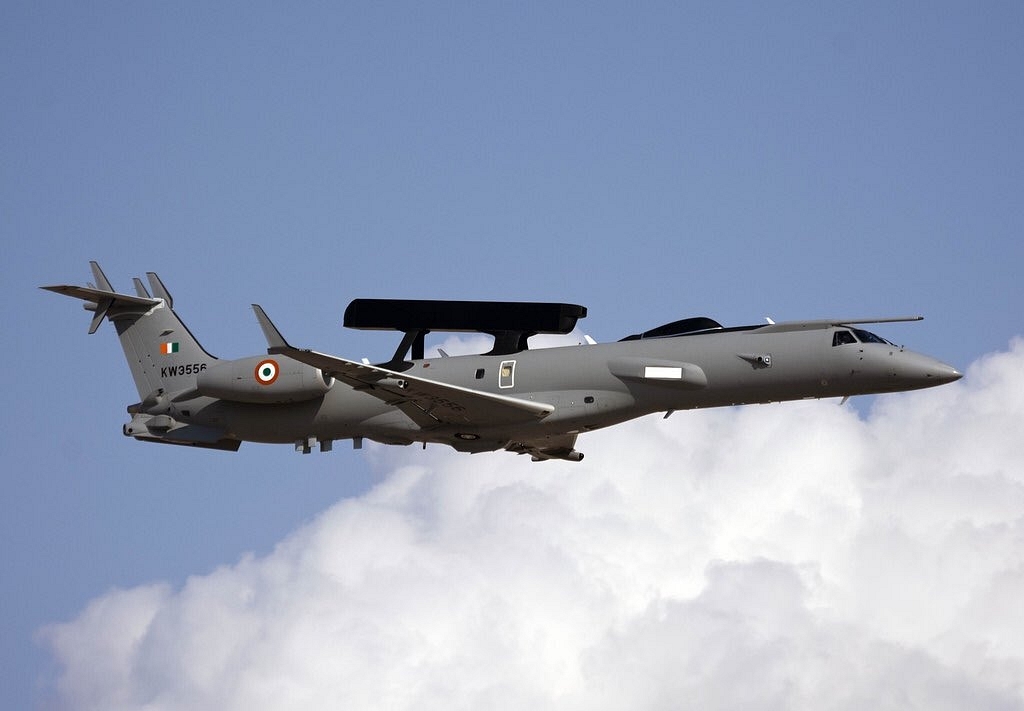Defence
India’s Eye In The Sky: New AEW&C System Boosts IAF’s Ability To Detect Hostile Aerial Activity
- Aero India 2017 saw the induction of the indigenously designed and developed AEW&C system.
- The system will augment IAF’s ability to provide advance warning about hostile aerial activity beyond enemy lines.
- It will also help in effective management of air assets, such as fighter jets and surface-to-air missiles, to neutralise the enemy.

Airborne early warning and control (AEW&C) system (Livefist/Twitter)
Aero India, the country’s premier air show, kicked off today at Bengaluru’s Yelahanka Air Force Station with the induction of indigenously designed and developed airborne early warning and control (AEW&C) systems into the Indian Air Force (IAF). Developed by the Defence Research and Development Organisation (DRDO) and mounted on the Brazilian-built Embraer ERJ 145 aircraft, this induction will put India into a select group of countries that have the capability to design and operationalise AEW&C systems.
Equipped with a 240-degree coverage radar that has a range of 250-375km, the system will augment IAF’s ability to provide advance warning about hostile aerial activity beyond enemy lines. The system will help in effective management of air assets, such as fighter jets and surface-to-air missiles, to neutralise the enemy and deny the use of airspace. It can be used in both defensive and offensive air operations.
An AEW&C aircraft works as a mobile radar platform and a command-and-control centre. The radar, placed on the fuselage (the main body of an aircraft), provides 240- or 360-degree coverage of the airspace and helps detect, identify and classify hostile intruders such as enemy missiles, aircraft, drones and ships. The enemy object, once tracked and identified, can be engaged and neutralised using air assets under the command-and-control centre.
India felt the need for an airborne early warning (AEW) platform for the first time during the 1971 Bangladesh liberation war, when the command and control could not be accomplished effectively from ground stations. Eying United States’ E-2C Hawkeye, the DRDO started developing an AEW system in 1985 under project ‘Guardian’. The programme was later renamed ‘Airavat’.
The system developed under this programme, mounted on the not-so-reliable British Hawker Siddeley HS 748 aircraft, was unveiled at the inauguration ceremony of the first Aero India show held in Bangalore in December 1996. The crash of the only test-bed in 1999, which killed eight scientists and the aircrew, forced the government to abandon the programme, and it was shut down in 2000. The IAF subsequently bought three AEW&C platforms from Israel in 2004 to fulfil its immediate needs. The project was restarted in 2003 under DRDO's Bengaluru-based Centre for Airborne Systems.
India currently has three Russian-built Beriev A-50 AEW aircraft fitted with Israeli-made Phalcon radars and two more are in order. The IAF also operates three Israeli Phalcon airborne warning and control systems (AWACS) mounted on Russian-built IL-76 planes. With the induction of the DRDO AEW&C system, the number of such aircraft currently operational with the IAF will go up to seven. DRDO is also expected to hand over the second home-made system to the IAF in the next few months.
Despite the rising number of these aircraft, India has plenty of catching up to do. Pakistan currently operates eight such aircraft, four of which have been supplied by China. People's Liberation Army Air Force has 20 AEW&C aircraft in its fleet. Both China and Pakistan are expected to add more AEW&C systems in the next few years.
To close the gap, India is planning to build six AEW&C systems on an Airbus platform. These will have a 300km range, 360-degree angle of coverage and will be much more sophisticated than the ones the DRDO is building currently.
The indigenous AEW&C system has attracted potential customers from across the world and will prove to be a big boost for the ‘Make In India’ initiative. Indonesia, which is set to hold the first-ever joint air combat drill with the IAF, has expressed interest in the system. Israel and Brazil have also done that. While Israel has its own AEW&C systems, Brazil supplies the aircraft on which the DRDO-built system is mounted.
The induction of the indigenous AEW&C system, though under-reported by the media, is a significant achievement for DRDO and IAF. The number of fighter squadrons in the IAF is declining with no end in sight. The induction will help in optimising available resources. Also, the DRDO recently suffered a blow when the Indian Navy rejected the naval version of its long-delayed Light Combat Aircraft Tejas for being too heavy. The success of the Rs 2,400-crore AEW&C programme, and other systems such as Advanced Pinaka, has come as a relief for the organisation that is often criticised for inefficiency and delays.
Support Swarajya's 50 Ground Reports Project & Sponsor A Story
Every general election Swarajya does a 50 ground reports project.
Aimed only at serious readers and those who appreciate the nuances of political undercurrents, the project provides a sense of India's electoral landscape. As you know, these reports are produced after considerable investment of travel, time and effort on the ground.
This time too we've kicked off the project in style and have covered over 30 constituencies already. If you're someone who appreciates such work and have enjoyed our coverage please consider sponsoring a ground report for just Rs 2999 to Rs 19,999 - it goes a long way in helping us produce more quality reportage.
You can also back this project by becoming a subscriber for as little as Rs 999 - so do click on this links and choose a plan that suits you and back us.
Click below to contribute.
Latest